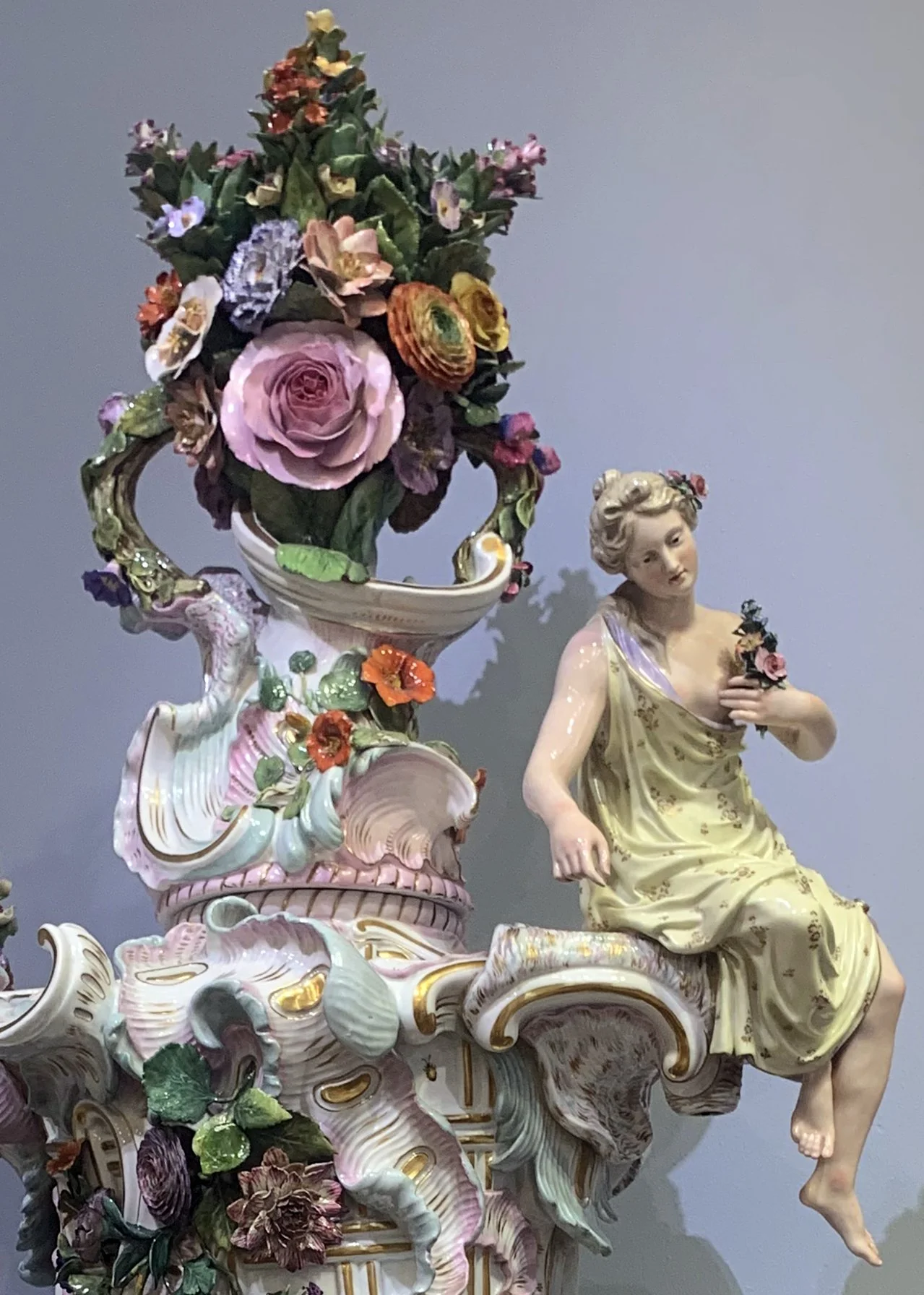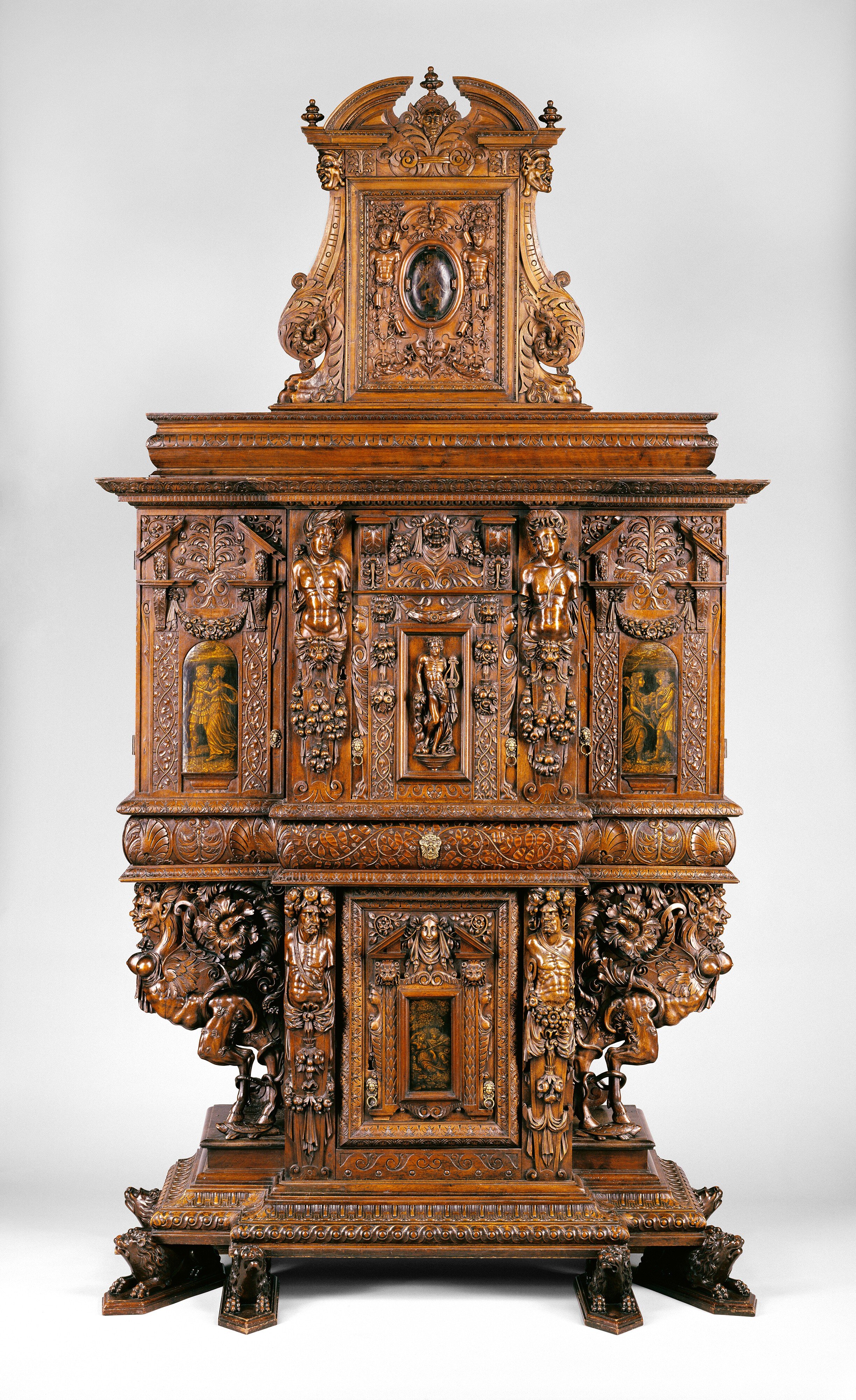A Determined Pleasure
Summer Meissen Porcelain Urn (detail), c. 1880. Porcelain and glaze, 128 x 50 x 50 cm. COURTESY OF WIKIPEDIA CREATIVE COMMONS.
Building a collection is more than simply accumulating objects — historian Michael J. Prokopow explores how acquisition transforms both the object and its owner.
At the core of Bruce Chatwin’s acclaimed 1988 novel Utz (narrated in the third person and opening with the under-attended funeral of the protagonist) is an interrogation of the complex psychology of collecting. The main character — the eccentric, bourgeois, pragmatic Kaspar Utz — is a German living in Czechoslovakia during the Cold War. Utz resides in a crammed, small two-bedroom apartment in 1970s Prague, filled with thousands of pieces of porcelain obtained across decades of upheaval caused by the Depression, World War II and the economic conditions of Stalinist Czechoslovakia. As Utz points out: “Wars, pogroms and revolutions offer excellent opportunities for the collector.”
Utz’s life in Prague is a surgically precise study in the emotional power of objects. For Utz, his collection is not only a marker of his expert knowledge and superb eye, but his cherished Meissen porcelains serve as tangible expressions of his sense of self. As a boy, some four years after the death of his father in World War I, Utz’s grandmother (a Jewish convert to Catholicism) gifted him a figure of a Harlequin he long admired. Then, Utz’s transformation from a naïve esthete into an enthralled and informed collector is presented as a matter of logical course. That he benefited from the disorder and violence of his times was justified because of the importance of his work. His passion for Meissen — financed by the inheritance he received from his grandmother’s estate — drives his unending, and at times amoral, quest for increasingly rare porcelain.
Significantly, an important consequence of his identity and status is that the Communist officials gave Utz permission each year to travel out of the country. It was during these excursions that he would visit dealers in both New York and London for the purpose of expanding his collection. Whenever he was in the West, he would invariably contemplate defecting. But to do so, as he well understood, would mean never seeing his beloved collection again, an unbearable price for freedom. Indeed, as Chatwin makes clear, Utz was as much a prisoner of his collection of porcelain figurines as the repressive state in which he lived.
While Chatwin’s depiction of the origin story and temperament of Utz the collector is extraordinary by virtue of its setting, it also captures the general temperament and behaviours of collectors of all kinds. Chatwin’s description of the urgency of the hunt, the pleasures of acquisition and the resulting feelings of attachment (and the complex pleasures of what functions as exquisite entrapment) are not unfamiliar to collectors. Collecting is a widespread phenomenon in the West — roughly between 35 to 40 per cent of North Americans and Britons identify as being collectors of some kind. The range of objects is quite vast, but whether salt-and-pepper shakers, matchbooks, antiques, contemporary art, wristwatches, first editions, or rare vinyl, the ethos of every collection is at once unique and consistent.
Meissen Porcelain Teapot, 1724-1725. Porcelain and glaze, 10.8 × 15 × 10.5 cm. COURTESY OF THE WALTERS ART MUSEUM.
II.
In all instances, collecting is a specialized type of acquisitive behaviour rooted in personal history, reflective of personality, and tied to social performance and differentiation. Often, there is an aspirational dimension to collecting, where the acquisition and display of objects serve to communicate a vision of a transformed and materially accomplished existence. Marketing professor Russell Belk notes that for the collector, the collection always functions as an extension of the self and represents an effort to render emotions tangibly. It is important to note that collecting is a focused intellectual and affectual undertaking that has both history and context. Collecting differs from other types of accumulation, such as the accumulation of goods that defines western consumerism; the realities of general material possession amassed over a lifetime; and what is clinically classified as hoarding, where the amassing of objects is often chaotic and motivated by psychiatric conditions.
And while an urgency of acquisition is characteristic of collecting, and while collectors can own hundreds and thousands of the objects of their affection (take Utz’s figurines as a fictional case in point), collecting activities tend to be marked by an orderly and determined mindset.
The phenomenon of collecting crosses time and cultures. Some notable examples include the well-documented demand for carved cameos in ancient Rome. Abbot Suger of France (b. 1081 C.E.) was renowned for his passion for acquiring exceptional antiquities. Suger’s extensive collection included an ancient Egyptian porphyry jar with later gold mounts in the form of an eagle and an equally ancient sardonyx chalice.
There emerged during the Renaissance, a culture of princely interests in “curiosities” which included animal skeletons, seashells, and what were regarded as fossils but which usually meant objects of all kinds simply dug out of the ground. Organized and displayed in specially designated rooms and cabinets (Wunderkammer and Kunstkabinett, respectively), these formal, focused efforts at creating comprehensive collections of natural and human-made artifacts were well documented in contemporary paintings and engravings.
(French) Cabinet, 1580. Walnut, oak, paint, iron, linen, and silk, 307.7 × 153.4 × 57.2 cm. COURTESY OF THE J. PAUL GETTY MUSEUM, LOS ANGELES, 71.DA.89.
Ferranti Imperato’s Dell’Historia Naturale (published in 1599) captured the intensity of this culture of collecting and contributed to the development of the formal museum. In the 18th and early 19th centuries, British aristocrats made grand tours of the lands of antiquity, creating collections which included architectural fragments, examples of pietra dura and Roman campagna paintings of idealized countrysides. These all contributed to the cultivation of the relaxed, eclectic esthetic that defined the public rooms of country houses at the time (and for which esthetic admiration continues).
Ferrante Imperato, Dell'Historia Naturale, 1599, printed 1672. Engraving. COURTESY OF ERLANGEN-NUREMBERG UNIVERSITY LIBRARY.
Inverted Jenny, 1918. Paper and ink (carmine rose and blue), 2.22 x 2.54 cm. COURTESY OF THE SMITHSONIAN NATIONAL POSTAL MUSEUM.
In the United States, in the complicated decades after the Civil War, these performative accumulation practices were taken up by industrialists, or “robber barons” as they were known. Aided by the British art dealer Lord Duveen, among others, these wealthy individuals filled their palatial Renaissance Revival mansions on 5th Avenue with pedigreed European furniture, paintings and sculptures.
That the act of collecting is influenced heavily by the cultural milieu of the collector is obvious. In the 20th century, with the broadening interest in — even popularization of — collecting and the surging, arguably nostalgic interest in recent history and events, collections included Liberty nickels, misprinted postage stamps of upside-down biplanes (the famous 24-cent “Inverted Jenny” of 1918) and baseball cards celebrating such greats as Honus Wagner, Mickey Mantle and Babe Ruth. The discovery of hard-to-find items would be much celebrated and receive news coverage. Sneaker collector Jordan Geller at one point could claim to own the largest collection of Nike and Air Jordan sneakers — some 2,388 pairs.
And given the countless other categories and subcategories of objects that form the basis of collections — whether quirky and idiosyncratic or curated — the histories of collecting are always simultaneously personal and tied to the realities of time and place.
Storage room at Duveen Brothers gallery, New York, n.d. COURTESY OF THE GETTY RESEARCH INSTITUTE, 2007.D.1.
III.
As Dutch cultural theorist Mieke Bal and others have noted (perhaps not surprisingly), collecting is always a narrative exercise. Here, the recounting of means by which an object is acquired follows the understanding that the discovered object will be transformed upon entering the collection. Given the mental and social imperatives attached to collecting, and how the process of searching and securing an object for a collection is always about a story within a larger story, the details and significance of the find invariably will be recounted in dramaturgical ways to all who are willing to listen.
The acquisition of an object for a collection — whether rare or commonplace — transforms a profane item into something sacred. Ordinary commodities are changed in their standing when inducted into a person’s collection. In the first instance, the story of a collection (whether narrated or observed) always has a beginning, a middle and an end, often marked by the death of the collector and the dispersal of their possessions by whatever means. The impulse to collect can be understood to operate as an anti-mortality strategy because there are always more things to find and own.
All of which affirms the complex mentalities of collecting. In the early 20th century, psychoanalysts Sigmund Freud and Werner Muensterberger offered theories about the motivations of collecting, holding, respectively, that the phenomenon was an outlet for excessive libido and a response to the legacies of childhood trauma. These theories, while intriguing, have beneficially been discredited by developments in neurobiology. Nevertheless, given the immense popularity of collecting, there is a logic in the search for understanding the motivations underpinning such behaviours.
While a complexity is inherent in collecting, there are also the pleasures of objects and the pursuit of them. That the vast majority of collectors seek to own the objects they seek gives credence to the arguments about the human instinct to gather possessions as a means of survival and well-being. Collecting may well be the apex of this hierarchy of material needs, with the attendant feelings of euphoria and sadness and the urgency of the self-fashioned mission being unavoidable.
Whether a person finds themselves drawn to endlessly beachcombing for perfectly round white stones or scouring thrift stores for cartoon memorabilia or textiles from Africa or movie posters or making a point of buying souvenir snow globes on every trip, the acquisition of a chosen object turns on an appreciation of the skills of makers and the joys of documentation and commemoration.
And as to the question of what happens to the objects acquired across a lifetime, it may well be that in most instances the dismantling of a precious hoard at the end of life — putting the objects back into circulation and the post-consumer marketplace — is the right course of action. To do so means affording others the thrills that accompany finding that special thing and ensuring that an aspect of social behaviour is perpetuated.
This article was published in the Fall/Winter 2022 issue of Studio Magazine













